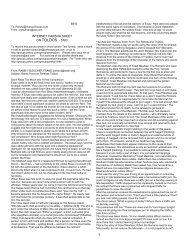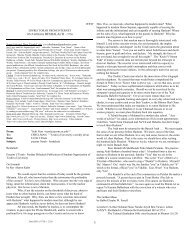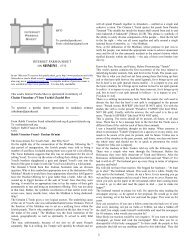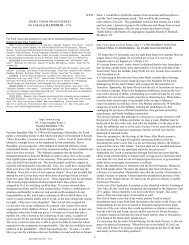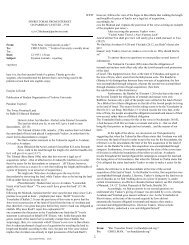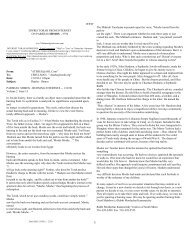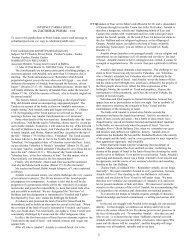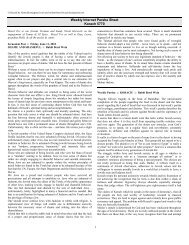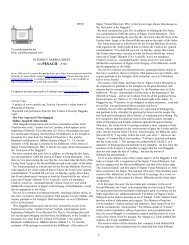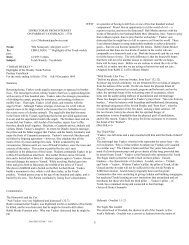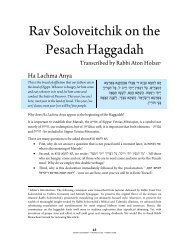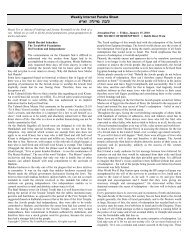Create successful ePaper yourself
Turn your PDF publications into a flip-book with our unique Google optimized e-Paper software.
for his children, who does not find time for his own advancement, willultimately not appreciate his children's spiritual development. One mustbe self-knowledgeable in order to acknowledge and appreciate another'slearning. "These are the generations of Noach." Noach was not a personwho neglected his own spiritual growth. The generations of the righteousare their good deeds. They understand the significance of their owndeeds. They accord them the same respect they would give to theiroffspring. While they continue to strive to transmit a legacy to theirchildren, they realize that if they do not study and perform mitzvos, theywill not have much of a legacy to transmit to their descendants.________________________________________________http://www.ou.org/torah/ti/default.htmOU Torah Insights ProjectParashat Noach October 16, 1999RABBI EPHRAIM Z. BUCHWALDSecular scholars speak of the story of the flood as if it were a myth,or a fairy tale. Not surprisingly, several ancient documents report strikingparallels to the story of the flood.Perhaps, the most famous document is the Babylonian "Epic ofGilgamish," which tells the story of a man by the name of Utnapishtim.The gods decide to destroy the earth, there is a great flood, and becauseUtnapishtim is the favorite of one of the gods, Eau, he is saved. Despitethe parallels between the "Epic of Gilgamish" and the Torah's story ofNoach, they are strikingly different. In the Babylonian story, the godsarbitrarily decide to destroy the earth as if it were a plaything.Furthermore, the gods choose to save Utnapishtim only because he is a"favorite" of theirs, not because he is worthy of being saved.In <strong>Parsha</strong>s Noach, however, there is a moral imperative. The world isflooded not because G-d arbitrarily decides to destroy the world, butbecause it had become corrupt and destructive. Noach is not arbitrarilysaved. He is deserving. He is a "righteous man, perfect in his generation.With G-d, Noach walked."But the flood changed Noach. After a year on the ark, Noach isfinally commanded by G-d to leave. A normal person would have beenjumping out his skin to get out of the ark. But Noach is hesitant to leave.Why?Elie Weisel, the great writer, offers a poignant insight. Weisel callsNoach the first "survivor." The world had experienced a Holocaust, andNoach was reluctant to walk out of the ark because he knew that theentire world was one giant graveyard for all the people he hadknownϕand he just couldn't face it. Once on dry land, after giving thanksto G-d and bringing sacrifices, the Torah tells us that Noach's reaction tothe flood is to plant. Planting after a great destruction is surely ameaningful and satisfying response. It represents hope and belief in thefuture.But what does Noach plant? He plants a vine and drinks the wine ofthe vineyard. He becomes drunk and wallows in the muck in his tent.Poor Noach. He cannot face the fact that everybody except himself andhis immediate family were destroyed in the flood. He is unable to facereality. He needs an escape and resorts to alcohol. He becomes adrunkard.Noach's response to the flood is not dissimilar to the reactions ofsome Holocaust survivors in our own generation. Some survivors werejust not capable of facing the fact that they were singled out to live,while their beloved friends and relatives, mothers, fathers, sons, anddaughters, had been murdered.What is the reaction of those who behold Noach in this desperatestate? The Torah tells us that Noach had three sons: Sheim, Cham, andYefes. Cham "saw [Noach's] nakedness" and told his two brothersoutside. Our Sages note that this expression has sexual connotations,and, in fact, Cham did not just mock is father; he sodomized or castratedhim. Sheim and Yefes respond to Cham's claim by taking a cloak andwalking backwards into Noach's tent, so that they would not see theirfather's nakedness. They took the cloak and covered him. When Noachawoke from his stupor, he knew what his youngest son, Cham, had doneto him. Noach cries out, "May Canaan be cursed." Oddly enough, Noachdoesn't curse his own son, Cham, but Cham's son, Canaan. "He willalways be a slave to his brothers."Very intriguing. Why does Noach curse his grandson and not hisson? Perhaps it is because, of all the children, Cham was the onlyone who was himself a father. Cham should have been aware of howdifficult it is to be a parent. Of all the children, Cham should have beenmost sensitive to Noach's plight. Yet he was the least sensitive!Noach says, if that's the way you behave, if that's the model youintend to provide for your children, if you respond to a person in need byacting insensitively, the end result will inevitably be that your own child,Canaan, will be a slave. Just like you, he will be unable to controlhimself. He will be a slave to his own passions and needs. Thestory of the flood is not at all a myth. It is a narrative replete with endlessfascinating insights, as is the entire Torah. All we need do is study andreview it, and in it we shall find the secrets of all human life and humanrelations.Rabbi Ephraim Z. Buchwald Rabbi Buchwald, Director, National JewishOutreach Program________________________________________________From: RABBI YISROEL CINER [SMTP:ciner@torah.org]PARSHA-INSIGHTS - <strong>Parsha</strong>s NoachThis week we read the parsha of Noach. A mere ten generations aftercreation, the world had reached a state of depravity that necessitated itsdestruction. However, "Noach ish tzaddik, tamim hayah b'dorosov{Noach was a righteous man, perfect in his generation}.[6:9]" OnlyNoach, his family and all those that would sheltered in his taivah {ark}would be saved from the flood. What were the grievous sins which werebeing committed? "And the land was destroyed before Elokim..." Rashiexplains that the "destroyed land" is a reference to its spiritual state, as itwas filled with adultery, incest and idol worship. "...And the land wasfilled with thievery. [6:11]" The usual term for thievery is 'gezel', yethere the passuk {verse} uses the term 'chamas.' The Medrash explainsthat this term refers to stealing an amount so insignificant that it isunclaimable in court (less than a sha'veh prutah). When a merchantwould bring out a basket full of lupines (a type of herb) to sell, peoplewere careful to come and steal only one or two stalks. Ultimately, thevendor was left with nothing.It's a bit hard to understand the mind-set of the 'dor ha'mabool' {thegeneration of the flood}. Adultery, incest and idolatry were all part of thedaily schedule. But stealing? Me? A thief? G-d forbid! I'd never reallysteal anything... Maybe help myself to a few lupines, (maybe a fewtowels from the hotel). But to steal? Heaven forbid! Why were thesedebased and corrupted people so careful to avoid actual stealing?Rav Sholom Schwadron zt"l explains that a person can be involvedin the worst of things and yet consider himself to be a tzaddik{righteous}. While he's enjoying that which he stole he's relishing thefeeling that he's so cautious and observant of the injunction againststealing. Rav Sholom relates that he was once walking through theback-streets of Jerusalem. In the distance he saw that when peoplewould pass near to a certain place, they would grab their noses and run.As he drew closer he started to smell a putrid odor but still didn't knowwhere it was coming from. As he drew even closer and the odor grewthat much stronger, he noticed a group of people gathered around a largesewage pit. Realizing that the sewer was the source of the smell, RavSholom's first inclination was to distance himself as quickly as he couldfrom there. However, he was overcome with curiosity. What fascinatingsight was holding the attention of all of those people in spite of thesickening odor? He too went close to the sewage pit and was amazed by2
what he saw. This was a very large, main sewage point into which manysmaller sewage routes emptied. As such, the stench was incredible.Inside were a number of workers trying to open up a blockage with, allof that which one expects to find in a sewer, flying all about. Amazingly,one of the workers had moved off to the side, cleared out a little area, sathimself down and was enjoying a falafel. The same enjoyment andsatisfaction that one feels when dining at an elegant restaurant was beingexperienced by this 'subterraneal sanitational engineer' in this sewer! AsRav Sholom was walking away (at a rather rapid pace) he began tocontemplate what lesson could be learned from what he had just seen.How was it that he was gagging from the smell already from a distanceand yet this worker, sitting in the midst of the smell's source, was able toenjoy his falafel? Why wasn't he gagging? Rav Sholom understood thatwhen one is in the midst of the stench, he doesn't even smell it...I recently took my sons to Yad Vashem, the holocaust memorialmuseum in Jerusalem. There's a quote there from one of the S.S. menwho was in charge of one of the concentration camps. He said that itwas very important, while being involved in his 'work' all day, to still bea good guy--a good father, husband and friend--once he got home. In themidst of the stench, one doesn't even smell it...The 'dor ha'mabool' {the generation of the flood} were able to relishtheir abstention from actual theft as they were committing every otherforbidden act in the book. I'm really a good guy. Those other acts don'tdefine who I am. This defines who I am. I'm really a wonderful person.No need for me to work on myself."Elokim said to Noach, the (time for the) end of all flesh has comebefore me because the land is filled with chamas {the aforementionedtype of stealing}.[6:13]" The ultimate cause of the flood wasn't theadultery or the idolatry--it was the 'chamas.' As such, it follows that the'new world order' which would follow the flood would deal with illicitlygained wealth...The Medrash relates that falsehood approached Noach, wanting toenter the ark. Noach responded that nothing can enter without a partner.Falsehood then met up with loss and destruction who asked, "Where areyou coming from?" Falsehood explained that Noach had turned himaway because he didn't have a partner. "Would you be my partner?" heasked loss and destruction. "What will you give me?" it responded.Falsehood offered a deal. "Any profit that comes about through me(through falsehood) will be given to you (loss and destruction)." Withthe deal agreed upon, they entered the ark. That deal stands until today.Good Shabbos, Yisroel Ciner <strong>Parsha</strong>-Insights, Copyright (c) 1999 by RabbiYisroel Ciner and Project Genesis, Inc. Rabbi Yisroel Ciner is a Rebbe [teacher] atNeveh Zion, http://www.neveh.org/ , located outside of Yerushalayim. ProjectGenesis: Torah on the Information Superhighway learn@torah.org 17 WarrenRoad, Suite 2B http://www.torah.org/ Baltimore, MD 21208 (410) 602-1350________________________________________________Yated Neeman USA Columns IHALACHA DISCUSSI<strong>ON</strong>: RECEIVING AN ALIYAH TO THETORAH BY RABBI D<strong>ON</strong>IEL NEUSTADTA minimum(1) of eight peopleϕa kohen, a levi, five yisraelim and anadditional person for maftir(2)ϕare called to the Torah every Shabbosmorning. If a kohen is unavailable, either a levi or a yisrael is calledinstead of him, but if a yisrael is called instead of a kohen, then a levican no longer be called after him(3). If a levi is unavailable, then thesame kohen who was called for kohen is called again(4).The procedure The person being called should take the shortestpossible route to the bimah so that there is no unnecessary delay. If all ofthe routes are equal in distance, he should ascend from the right side(5).Before reciting the blessing, the oleh should look inside the Torah to seewhere the ba'al koreh will begin reading. He then rolls up the scroll andrecites Borchu followed by the first blessing. Alternatively, he may leavethe scroll unrolled but closes his eyes while reciting Borchu and theblessing(6). After the reading is over, the sefer should be rolled up andthe final blessing recited. The final blessing should not be recited over anopen sefer even if one keeps his eyes closed. The blessings must berecited loud enough so that at least ten people are able to hear them. Theposkim are extremely critical of those who recite the blessings in anundertone(7).Who is called to the Torah? While it is appropriate and preferable tocall to the Torah only those who are G-d fearing Jews who observe themitzvos, when the need arises or for the sake of peace it is permitted tocall even non-observant Jews(8). But under no circumstances is itpermitted to call non-believers to the Torah, for their blessings are notconsidered blessings at all. If absolutely necessary, it may be permittedto accord them honors that do not necessitate a blessing, e.g., hagbahahor gelilah(9). Most often the aliyos are allocated in rotating order or atthe gabbai's discretion. But it is a long-standing tradition which hasbecome universally accepted to mark milestone events by receiving analiyah. People marking such events are called chiyuvim, since customdictates that they are obligated to receive an aliyah. Sometimes, however,there are not enough aliyos for all of the people who are chiyuvim(10).Based on the opinion of the majority of the poskim, the following, inorder of priority, is a list of the chiyuvim who are entitled to analiyah(11): ϕA chasan(12) on the Shabbos before his wedding [or on theShabbos before he leaves his hometown to travel to his wedding]. (13)Achild(14) who becomes bar mitzvah on that Shabbos(15). ϕThe father ofa newborn(16) boy or girl, if the mother is in shul for the fir st time sincegiving birth(17). A chasan on the Shabbos after his wedding, if thewedding took place on Wednesday or later in the week. ϕA Shabbosyahrtzeit(18). The father of baby boy(19) whose bris will be thatShabbos or during the coming week(20). ϕA chasan on the Shabbos afterhis wedding, if his wedding took place before Wednesday. A yahrtzeitduring the upcoming week(21). ϕOne who must recite the ha-Gomelblessing(22). ϕOne who is embarking on or returning from a journey.ϕAn important guest.Consecutive aliyos for relatives In order to avoid ayin harah, a "badomen", the gabbai does not call a father and a son or two brothers [whoshare a father] for consecutive aliyos(23). Even if the parties involvedare not concerned with ayin harah and wish to be called consecutively, itis not permitted(24). Moreover, even if the gabbai mistakenly did call therelative for a consecutive aliyah, the one who was called should remainin his seat and not accept the aliyah(25). If, however, the mistake wasrealized only after he ascended the bimah, then he is not instructed todescend(26). L"chatchillah, even brothers who share only a mother, oreven a grandfather and his grandson, should not be called forconsecutive aliyos. If, however, there is a need to do so, orifϕb"dievedϕthe call to ascend to the bimah was already made, it ispermitted for them to accept the aliyah(27). All other relatives may becalled consecutively even l"chatchillah. The consecutive aliyosrestriction does not apply: ϕIf the consecutive aliyah is the maftir on aday when a second sefer Torah is read for maftir. e.g., on Yom Tov orRosh Chodesh or when the Four Parshios are read(28). ϕIf the maftir isread by a minor (one who is not yet bar mitzvah)(29). ϕWhen the namesof the olim are not used when they are called for an aliyah. While mostAshkanezic shuls today do use names when calling the olim, in somecongregations no names are used for the shevii or acharon aliyos(30).ϕTo hagbahah and gelilah, provided that they are not called byname(31). ϕIf another person was called for his aliyah between them andthat person happened not to be in shul or was unavailable to receive hisaliyah(32).1 Some congregations add aliyos while others do not. Since both practices have a basis inhalachah, each congregations should follow its own custom. 2 Who can be either a kohen, levior yisrael. Those congregations who add aliyos may also call a kohen or a levi for the lastaliyah (called acharon), but should not call kohen or a levi for any of th e other additionalaliyos; Mishnah Berurah 135:36-37. 3 O.C. 135:6. 4 O.C. 135:8. 5 O.C. 141:7. 6 MishnahBerurah 139:19. The third choice, which is to leave the sefer open but turn one's head to theleft, is not recommended by the poskim, including the Mishnah Berurah. 7 O.C. 139:6. See3
Chayei Adam 31:12. 8 Preferably, he should be called only after the first seven aliyos; Pe'erha-Dor 3, pg. 36, oral ruling from Chazon Ish. 9 Igros Moshe O.C. 3:12,21,22. 10 A generalrule is that members of a shul have priority over non-members, even if the non-member'schiyuv takes priority over the member's. 11 This list covers the Shabbos kerias ha -Torah only.12 Who has not been married before. 13 If both the aufruf and the bar mitzvah want the samealiyah, then the one who is a greater talmid chacham has priority. If that cannot be determined,then the two should draw lots. Lots should be drawn whenever two chiuyvim lay equal claim toan aliyah. 14 The father of the child, however, is not a chiyuv at all; Sha'ar Efrayi m 2:10. 15According to some opinions, the same chiyuv applies even if the child became bar mitzvahduring the past week; Harav C. Kanivesky (Ishei Yisrael, pg. 409). 16 Even if the baby wasstillborn; Sha'arei Efrayim 2:5. 17 If the wife is not in shul, then the husband has an obligationto receive an aliyah when 40 days have elapsed from the birth of a male child, or 80 days fromthe birth of a female child. 18 A yahrtzeit chiyuv is only for a father or a mother. A yahrtzeit fora father has priority over a yahrtzeit for a mother; Kaf ha-Chayim 284:6. 19 A father of a babygirl who is naming her on Shabbos has priority over a father of a baby boy whose bris will takeplace during the week; Da'as Torah 282:7. 20 According to some opinions, if the bris will takeplace on Shabbos, then the father is a greater chiyuv than a yahrtzeit on that Shabbos; IsheiYisrael, pg. 410. 21 If two people have yahrzeit during the week, the one whose yahrtzeit isearlier in the week has priority; Kaf ha-Chayim 284:6. 22 Ha-Gomel can be recited without analiyah. 23 O.C. 141:6. 24 Mishnah Berurah 141:19. Aruch ha -Shulchan 141:8 maintains,however, that one who is unconcerned with ayin harah may do as he wishes. 25 Be'er Heitev141:5; Sha'arei Efrayim 1:33. 26 Mishnah Berurah 141:18. 27 Sha'arei Efrayim 1:33. 28Mishnah Berurah 141:20. Some poskim do not recommend relying on this leniency when nokaddish is recited between the aliyos, e.g., Chol ha -Moed Pesach (Sha'arei Efrayim 1:32),while others are not particular about that (Aruch ha-Shulchan 141:8). On Simchas Torah,however, all poskim are lenient about this; see Yechaveh Da'as 3:50. 29 Mishnah Berurah141:20. 30 Mishnah Berurah 141:21. 31 Teshuvos Avnei Chefetz 16. 32 Sha'arei Efrayim 1:30.________________________________________________From: Rabbi Mordechai Kamenetzky[SMTP:rmk@torah.org]DRASHA PARSHAS <strong>NOACH</strong> -- LANGUAGE BARRIER RABBIMORDECHAI KAMENETZKYThe lessons of the flood were just washed away. 340 years later thehumans were up to their rebellious antics. This time, however, they wereunified in rebellion. They decided that they would battle the Almightyby building a Tower that would ascend to the heavens. But their planswould topple like a house of cards. Hashem turned to his celestial hostsand declared, "Let Us descend and confuse their language that theyshould not understand one another's language" (Braishis 11:7). Havocreigned. When one construction worker asked for a brick he was handeda hammer. Someone asked for a ladder and they got a trowel. The onlything being built was discord and mistrust. Within days the project fellapart and the people and their languages were dispersed. Why, however,did Hashem choose to destroy this project through a most delicatemanner. Why not have a wind topple the tower or an earthquake shatterit. What message did Hashem send by confusing the languages?Jacob M. Braude, a former Illinois judge, tells the story of anAmerican visiting the UK who was driving with an Englishman throughLondon. During their trip some mud splattered on the car and theEnglishman commented that the car's windscreen needed a cleaning."Windshield," retorted the American. "Well, on this side of the pond wecall it a windscreen." "Then you're wrong," argued the American. "Afterall, we Americans invented the automobile, and we call it a windshield."That is mighty dandy," snapped the Englishman. "But who invented thelanguage?"My brother-in-law Rabbi Yitzchak Knobel, founder of YeshivaGedolah Ateres Yaakov in Woodmere, once noted something amazing.Though Hashem acts independently and needs not consult with anybeing before executing any decision, the Torah on a few occasions hasHim descending to observe, and even consult with his celestial tribunalbefore taking action. Last week, before creating man, the Torah quotesHashem speaking, "Let Us make man." This week, when deciding toconfuse the language of humankind, thus inhibiting the ability tocommunicate, Hashem also consults with inferiors. "Let Us descend andconfuse." Hashem does not say, "I will descend and confuse." Bothinstances must be related.The power of man over his co-creations is his ability to express hisinnermost feelings and expressions. The creation of man was more thanthe creation a physical entity with complex motor functions. It was thecreation of a being with the power of expression the power tocommunicate. When Hashem decided to remove the ability tocommunicate, He returned to his original tribunal the ones He originallyconsulted while empowering speech in humankind. The greatestdownfall of humankind is the removal of his superiority over the rest ofthe animal kingdom. That is accomplished when he does notcommunicate.Recently, a billion dollar project to Mars was destroyed because thelanguage of the metric system was spoken in one factory and feet andinches were spoken in the other.Hashem taught those builders who wanted to reach G-d that theirmortality did not lie in lime or mortar. Rather it lay in the smallintangible gift that we all take for granted, yet is so fragile and notutilized properly. Our mortality begins and ends with our power to talkproperly and for the correct reasons to our fellow human beings.Good Shabbos Rabbi Mordechai Kamenetzky Dedicated in memory ofReb Shimon Sumner by the Oliner Family Join Rabbi Kamenetzky in a 5 weekSeries "Back to The Future" - Exploring the Personalities in the Book of GenesisMonday Evenings at The Young Israel of Great Neck - call 516-482-6886 fordetails. If you would like to be on a shiur update list which sends messagesregarding Rabbi Mordechai Kamenetzky's various lectures in NY City and LongIsland and other locations, please send a blank email tormkshiur-subscribe@jif.org.il You will receive bulletins about those classes.Drasha, Copyright (c) 1999 by Rabbi M. Kamenetzky and Project Genesis, Inc.Drasha is the e-mail edition of FaxHomily, a Project of the Henry and MyrtleHirsch Foundation. Rabbi Mordechai Kamenetzky is the Associate Dean of theYeshiva of South Shore, http://www.yoss.org/ . Project Genesis: Torah on theInformation Superhighway learn@torah.org 17 Warren Road, Suite 2Bhttp://www.torah.org/ Baltimore, MD 21208 (410) 602-1350 FAX: 602-1351________________________________________________From: Yated[SMTP:yated-usa@yated.com]KORTZ UN SHARFι SHORT AND SWEET PARSHA VERTLACHBY SHAYA GOTTLIEB"Eleh Toldos Noach, Noach Ish Tzaddik." These are the children ofNoach, Noach was a tzaddik. 6:9 Rashi: The children of the tzaddikimare their maasim tovim. The Yid Hakodosh of P'shischa said, "Manypeople toil in parnossa and spend their lives ammassing money andproperty for their children. When the children are grown, they, too,spend their time and energy preparing for their children. And so it goes,from generation to generationϕeveryone gives the same excuse, that theyare working for their children. I would like to see that child, for whomevery father during all the generations has toiled!" Thus the meaning ofthe possuk, "These are the children." Noach did not merely work for hischildren. He considered himself a child as well, and toiled on his ownshleimus, his own Avodas Hashem. He was his own 'child'. As Rashisaid, "The children of the Tzaddikim are their maasim." Tzaddikimconsider their deeds as obligatory as providing for their own children.ϕBais Yaakov; Rav Yaakov Aharon of AlexanderRav Yoshe Ber of Brisk often said, "I have worked my entire life notto rely on my children's zechuyos, that their deeds should not be my onlyentry to Olam Habo." This is alluded to in, "The children of thetzaddikim are their good deeds." Tzaddikim do not rely on theirchildren's merits, but work to amass their own.The title "Ish Tzaddik" was earned by Noach because he wsn't only atzaddik bayn odom l'Mokom, between himself and Hakodosh BoruchHu, "Es Hoelokim Hishalech6". Noach was "Tomim Hoyo B'dorosov",righteous in his dealings with other people as well. ϕRav Yitzchok ofVolozhin"Tomim Hoyo B'dorosov"ϕ he was a 'tomim', complete, in hisgeneration. 6:9 Noach remained humble in his own estimation. Eventhough he was an only tzaddik in the entire generation of wicked men, itdid not make him arrogant. "Es Hoelokim Hishalech"ϕbecause Noachconstantly contemplated the "gadlus haBorei", his own good deeds were4
not especially great in his eyes. When he compared his spiritual standingto the greatness of "Elokim", he remained humble and 'tomim'. ϕNoamMegadim"Eleh Toldos Noach Vayoled Noach Es Shem, Es Chom, V'esYofes." These are the children of Noach, Shem, Chom, and Yofes. 6:9Rashi: The primary children of tzaddikim are their maasim tovim. Thispossuk alludes to three things that Noach internalized. Shem, toremember Hashem's name; Chom, to have a 'chamimus' to a mitzva, andYofes, to do things that are "tiferes l'oseho v'tiferes lo min hoodom."ϕThe Rebbe of P'shischa________________________________________________http://www.tabc.org/koltorah/Noach KOL TORAH A Student Publication of the Torah Academy ofBergen County 4 Cheshvan, 5752 October 31, 1992SEEING A RAINBOW BY RABBI MICHAEL TAUBESThe Torah tells us that after the Mabul, Hashem decided that Hewould never destroy the world again by flooding it, and He emphasizedthe point by establishing a special covenant to guarantee it. He thenadded that the rainbow which would periodically be seen in the cloudswould serve as the symbol of this covenant. The Mishnah in Pirkei Avosindicates that the rainbow actually existed long before the Mabul, havingbeen one of the items created on Erev Shabbos just before nightfall ofthe first Shabbos in history. The Gemara in Berachos states that one whosees a rainbow must make a Beracha, the text of which refers to theaforementioned covenant and also, as the Maharsha points out, to thisidea that the rainbow existed since the Sheishes Yemei Bereishis.Rabbeinu Yehudah bar Yakar (a teacher of the Ramban) writes in hisPeirush HaTefillos Vehaberachos that although the Pesukim imply thatthe rainbow "reminds" Hashem of His promise not to destroy the worldwhen He seems to want to do so, Hashem, of course, needs no remindersbecause He forgets nothing. Rather, He is showing the people on earthwho see the rainbow that there is too much wickedness in the world andthat if not for His oath never to destroy the world, He would do so rightthen, just as He created and destroyed other worlds before this oneexisted, as mentioned in the Midrash. Therefore, he adds, one ought tobe inspired to do Teshuvah when seeing a rainbow. With thisexplanation in mind, perhaps, the Chayei Adam cites an opinion that onewho sees a rainbow should not tell anyone else about it because hewould be spreading a negative report about the inhabitants of the worldby publicizing that they deserve to be destroyed at the moment.The Gemara in Chagiga states that one who gazes at a rainbowdisplays disrespect for Hashem because the Posuk in Yechezkel says thatHashem's appearance is somewhat similar to that of a rainbow (in theeyes of Yechezkel). The Gemara then adds that one's eyesight can fail ifhe gazes at a rainbow. The question may be raised as to how one canever look at a rainbow and make the Beracha upon seeing it if it isimproper to gaze at it altogether. The Beis Yosef quotes from theAvudraham that the Rosh was asked this question and responded that the"looking" necessary in order to require a Beracha is not the same as"gazing" which is considered inappropriate. Thus it is fine to see arainbow and subsequently make the beracha; what is forbidden is staringat it with care and precision. The Tur therefore writes that it is prohibitedto stare at a rainbow; the Shulchan Aruch likewise prohibits gazing at arainbow excessively. The G'ra stresses that one must see the rainbow inorder to make the Beracha; the only prohibition is against staring at itand examining it closely. The Mishnah Berurah states that one shouldtherefore simply see it and make the Beracha right away.How often should one recite this Beracha? The Shaarei Teshuvahrules that although the Gemara in Berachos suggests that the Beracharequired upon seeing certain things is recited no more than once everythirty days, the Beracha on the rainbow may be recited many times inthirty days because when one sees a rainbow again, it is presumably anew one, since the old one has already disappeared. The MishnahBerurah accepts this ruling. In the Biur Halacha, however, he adds that itis unclear whether one must see the entire rainbow (in the shape of abow) in order to make the Beracha, or whether seeing a part of itsuffices. It would thus seem that because of this doubt, one perhapsshould not make the Beracha unless he has seen the entire rainbow.________________________________________________From: RABBI J<strong>ON</strong>ATHAN SCHWARTZ[SMTP:jschwrtz@ymail.yu.edu]Prologue: Some recall him L'Shevach and some L'Genai. It is a verywell known statement of the Midrash that people often can parrot fromRashi concerning Noach. While many Derashos struggle with an attemptto reconcile the two opinions, one could simply ask himself why we aredaring to deify or vilify Noach? Additionally, while trying to reconcilethe two opinions (In his generation he was a Tzaddik vs. not being theTzaddik of Avraham's character) we must ask ourselves why Chazal usesuch strong, diametrically opposing recollections of Noach (Shevach andGenai) when it seems as if the Midrash is merely trying to contrastNoach in different situations and terms like 'Tzaddik' vs. 'less Tzaddik'would apply better?Moreinu Harav Yosef Blau Shlita (Sichos, <strong>5760</strong>) suggested thatwhen talking about Noach one must remember that Chazal were notsimply contrasting him with Avraham or the people of his generation.Rather, from a closer examination of Chazal, it appears that the twopositions taken were taken about Noach himself. (Yesh Dorshin OSOL'Shvach) The statements are made about Noach and clearly concernhim. Harav Blau shlita suggested that Noach the man, later classifiedhimself following the flood. As the Possuk tells us, he went from IshTzaddik to Ish Ha'adama. In fact, he did not go from one level to theother. Rather, when there was no one left in the world and he was tobegin anew, Noach was who he was, an Ish Ha'adama. The question ofShevach or Genai is a question of discussing how this man dealt withhis own life. L'Genai, he was a Tzaddik only in the face of adversity.Avraham, by contrast, was a Tzaddik all the time. Lacking the ability torise to the occasion all the time is a Genai of Noach.Others disagree. They feel that the ability to stand up to adversity,especially when the individual's internal locus of character is somewhatweaker, is a marked shevach. Noach was an Ish Ha'Adama. He could notconvince the people of his generation to stay off the flood. Still, thisindividual did not succumb to the pressures of society. He did not parrotthe actions of the world around him and stood up to th at world forhimself anyway. That is a Shevach and a strong one according to thisposition (See TBP-YIJE, 5759).Hence, when discussing a character who appears in a Sefer ofMa'aseh Avos Siman L'Banim, Chazal dare to try to discuss the power ofNoach's activities. As a Tzaddik he could withstand adversity against hisnature (of Ish Ha'Adama) and withstand society because he knew theywere wrong. However, as a full role model, he was not able to withstandhimself, he lacked the consistency of an Avraham. These two statementsare ones about Noach the person and are, by definition diametricallyopposed.Often when facing challenges or tough decisions we are called uponto make decisions. Sometimes we can withstand the 'peer pressure' whileat other times we feel overwhelmed. However, society is quicklydeveloping a new category of decision making. This category refuses torecognize a decision. It turns down the right to think and merely mimickspatterns the individual has learned without providing much thought tothe decision-making process. It leaves us like parrots in our own homes.This week's Chaburah discusses the appropriateness of having parrots inour homes entitled: Pet peeves ...Battala News Mazal Tov to SHRAGA AND PERRI GOLDENHERSHand family upon the birth of Leeba. She'Tizku L'gadela L'torah L'chuppa5
U'l'Maasim Tovim.Mazal Tov to JOSH WISOTSKY and family upon his Aufruf andforthcoming marriage to LEAH SHENKER________________________________________________From:Ohr Somayach[SMTP:ohr@virtual.co.il]* TORAH WEEKLY * Highlights of the Weekly Torah Portion<strong>Parsha</strong>t Noach InsightsWe Have The Technology "They said to one another, `Come, let usmake bricks and burn them in fire.' And the brick served them as stone,and the lime served them as mortar." (11:3) Technology is the conceit ofthe modern world. The GNS system in our car allows us to receivesatellite signals locating our position to within six feet anywhere on theplanet. Behind the helm of our trusty gleaming V-8, we are the kings ofthe road. Previous generations pale into technological primitives. Wehave the technology. With a cellular phone we can call from the desert,from the top of a mountain, from the middle of nowhere, andcommunicate to anywhere in the world. And what are those deathlesswords that we wish to communicate across the tens of thousands ofmiles? "Hi! Guess where I am!" Now that's what I call progress. We mayknow where our car is better than ever before, but when it comes toknowing where we ourselves are -- that's a different story. If we haddeveloped in any real sense over the last couple of thousand years,would we still find anything of value in Shakespeare? If the humanspirit had undergone a comparable degree of progress to technology, thepoetry and art of those who died hundreds of years ago should seemimpossibly quaint to the modern eye. If we were really more advanced,no-one should be in the slightest bit interested in John Don ne,Cervantes, Sophocles, Pascal, Mozart or Boticelli -- except forhistorians. And yet, we recognize that our generation is hard put tocome anywhere close to these artists. Technology is an apology for ourfeelings of inferiority when we compare ourselves to our forebears. Ouraxiom is "We may have less to say, but we can say it from the middle ofnowhere." Cold comfort is better than none.At the end of this week's <strong>Parsha</strong>, the Torah describes the attempt ofthe Generation of Dispersion (Dor Hapalaga) to build a tower thatreached into the sky. "They said to one another, `Come, let us makebricks and burn them in fire.' And the brick served them as stone, andthe lime served them as mortar." Rashi comments: "In Babylon therewere no stones.." Because there were no rocks in Babylon, they wereforced to apply technology and invent the brick. Immediately followingthis verse they say, "Come, let us build a city and a tower with its top inthe heavens..." They wanted to make a tower to challenge G-d. This is aseeming non-sequitur. What does the lack of stones in Babylon have todo with building a city and a tower to challenge G-d? Why is makingbricks a harbinger of incipient rebellion?The Dor Hapalaga were intoxicated with technology. Bricks werethe Babylonian equivalent of a Saturn V rocket. Take some mud, bakeit and voila! Genius. If man can take mud and turn it into towers andspires and palaces, what can he not do? Is there a limit to his powers?From this kind of thinking there is a very small step for mankind tothink that they can dispense with G-d completely."Let us build and make for us a name." We have the technology.Sources: * Rabbi Yosef Chaim Sonnenfeld, Rabbi Yissocher FrandWritten and Compiled by Rabbi Yaakov Asher Sinclair General Editor:Rabbi Moshe Newman Production Design: Eli Ballon Ohr Somayach International22 Shimon Hatzadik Street, POB 18103 Jerusalem 91180, Israel Tel:972-2-581-0315 Fax: 972-2-581-2890 E-Mail: info@ohr.org.il Home Page:http://www.ohr.org.il (C) 1999 Ohr Somayach International________________________________________________From: Yeshivat Har Etzion's Israel Koschitzky Virtual Beit Midrash yhe@vbm-torah.orgTo: yhe-mb@vbm-torah.orgMISHNA BERURA SHIUR #89: Siman 154BY RAV ASHER MEIRSIMAN 154 - WHAT IS C<strong>ON</strong>SIDERED A "TASHMISH KEDUSHA" In the MBand BH on our siman, we find three distinct levels of sanctification or dedication:1. KEDUSHA: Sifrei Torah, tefillin, and mezuzuot are considered to have actual"kedusha" - holiness. These are not profane items which were then dedicated to holy use butrather items whose very creation is predicated on an intention to invest them with sanctity.The MB adds another member of this category in s.k.7. According to the abovedefinition, is this addition still relevant nowadays (for printed books)? The Mishna Berura(s.k.9) seems to imply that it is - but pay attention to the source (from a son of the Rosh,who lived about a hundred years before Gutenberg). We discuss this issue in detail below.2. TASHMISHEI KEDUSHA - items which serve (mishamesh) objects of kedusha. Anexample would be a Torah cover. The MB in s.k.7 adds the pouch in which tefillin areheld. Nowadays almost everyone keeps his tefillin in special boxes (the MB calls this a"nartik" - see e.g. MB 42:2.) which cover the whole tefillin. Is the pouch still considered a"tashmish kedusha?" According to s.k.14, it depends on whether we view the pouch asH<strong>ON</strong>ORING the tefillin or as PROTECTING them. (For the answer to the question, seeBeur Halakha at the end of siman 34 - d.h. "shtei zugot.")3. TASHMISHEI MITZVA - items which are set aside to be used for a mitzva. In s.k.6the MB refers us to siman 21; there he mentions the examples of succa, lulav, and shofar. Insiman 153 (s.k.37 and 48) the MB implies that a beit knesset also belongs in this category.The fact that the second level is called a "TASHMISH kedusha" and the third doesn't have theword "kedusha" in its description at all does not mean that levels two and three do not have"kedusha." Of course they do, and the MB refers several times to "kedushat beit knesset."(Example in our siman: BH d.h. "aval aron.") Here are some of the differences.1. DIVREI KEDUSHA can certainly never be used for any other purpose. Theirsanctity can never be conditional. Even preparing something (hazmana) for kedusha maysanctify it. (SA Orach Chaim 42:3.)2. TASHMISHEI KEDUSHA even if sold in a permissible way retain their sanctity.(MB 153:37.) However, their sanctity CAN be originally conferred temporarily orconditionally. (Rema on Orach Chaim 42:3). The Beur Halakha in our siman (d.h.tashmishei kedusha) discusses if it is ever possible for their sanctity to lapse barring anexplicit condition.3. TASHMISHEI MITZVA if sold in a permissible way lose all of their sanctity - thoughunder some conditions the proceeds may retain it. (MB 153:37.)In many places the MB refers to a fourth category "tashmish detashmish" -something which serves a "tashmish kedusha." These have NO sanctity (MB 42:9) and theMB on our siman (s.k.6) indicates that at any time they may be diverted to secular purposes.PROPER REVERENCE FOR HOLY BOOKS In s.k.31, the MB li sts a number ofrestrictions which demonstrate our reverence for "sifrei kodesh" - holy books. (Interestingly,one of them is discussed in hilkhot Shabbat - see SA Orach Chaim 315:7 and the MB there).Are these restrictions due to the holiness of the OBJECT of the book? If that is the case, weneed to ask if the printing process is halakhically equivalent to writing, and is equally capableof investing an object with sanctity. Or are they due to respect for the WORDS OF TORAHwhich we can learn from the books - in which case the restrictions should certainly apply toprinted books and perhaps even to magnetic media (audio and video cassettes, floppy disks)and optical media (CD-ROM's - like the ones I use in preparing these shiurim to provide themwith the "virtual bekiut" their preparation demands)?PRINTING Some chronology is in order. Moveable type was invented byGutenberg around the year 5210, secular date 1450. Within a generation Hebrewprinting was widespread; for instance, I have found several responsa of the Re'em (RavEliyahu Mizrachi - passed away in 5258/1498 CE) which refer to books of "defus" - printing.The Re'em often compares the printed books with manuscripts which constituted allsefarim until the advent of Hebrew printing. This time period is just about the generationwhich separates Rishonim from Acharonim (Avraham Brauner's book classifies the Re'em as aRishon and his student Maharam Alshaker, who was born about fifteen years later, as anAcharon) and we could even characterize the "Acharonim" as that generation of scholarswho grew up with printed books. One by-product of printing was a lot of Torahmaterial which was discarded. The printing process itself produced waste such as galleys,trial printings, pages which didn't turn out and so on. In addition, the monumental decreasein the price of books meant that books would be considered worn -out at an earlier stage oftheir decline. For centuries, the bindings of books were made by gluing together andpressing pages from discarded books, and among these discarded books were Hebrew holybooks. This problem is decried in the MB s.k.31. Over three hundred years earlier thispractice disturbed the Maharshdam (YD 184); and the claims of the binders that they hadreceived a lenient ruling in the matter did not seem credible to him.The Maharshdam suggests four possible rea sons for leniency: 1. Printing is not"writing" but rather "engraving" - "chakika." 2. In printing, many letters are printed all atonce - as opposed to writing in which each letter is written individually. 3. Torah scroll,tefillin and mezuzot need to be written on parchment; books are printed on paper. 4.Hand-written books are written with intention (lishma), unlike printed books which arecreated automatically.Ultimately, he rejects all four candidates. Regard ing ENGRAVING, theMaharshdam cites a responsum of the Rambam (268) in which the Rambam explicitlyrules that there is no difference between writing, engraving or even embroidering. TheRambam proves this from Yoma 37b which indicates that the oath of the Sota was engravedon a metal tablet, and even so had to be written in a special shorthand so as to evade theprohibition of writing Torah verses other than in a chumash. Regarding the simultaneousprinting of the letters, as far as I can tell this is not discussed in the Maharshdam nor inthe Rambam which he uses as a reference. However, we could readily bring a proof fromYoma 38b. The mishna relates that the Sages denounced Ben Kamtzar who refused to"teach writing." The gemara explains that he had the ability to take four quills between his6
In its opening lines, the narrative describes a known geographic area: "a valley in the landof Shinar," or Mesopotamia, and at its close it names the city of Bavel, one of the oldest andmost famous in the ancient Near East, mentioned repeatedly in Scripture, and site of theearliest archeological excavations. The city of Bavel was already very large in theearliest extant records, and its temple to Mardukh was distinguished; its tower as well wasthe grandest in ancient Babyloni earning it the appellation, "The House of the Foundation ofHeaven and Earth." The ruins of this tower, which our episode deals with, are visible today(for those who have the opportunity to stroll through rural Iraq), and they were excavated atthe turn of the century. We do not know exactl y when the tower and temple of Bavel werebuilt - nor did the ancient inhabitants of the city. But we do know that the ancient inhabitantsof the city were quite proud of their edifices, attributing their construction to the godsthemselves. The towers, or ziggurats, were meant to serve as a point of encounter betweenthe gods (dwelling in the heavens) and man (dwelling on earth). A stunning set of stairssurrounded the tower, allowing the priests to ascend to its apex. At the tower's top sat atemple, in which the priest would "meet" the gods. With this background in mind, itappears that the traditional exegetes erred in seeing the expression "with its top in theheavens" as hyperbole. The ziggurat's architects and their followers truly intended for thetower to reach the heavens, the residence of the gods. Knowledge of these historical andarcheological facts compelled Cassuto to explain our narrative as satire, intended to mockthe pagan pride of Bavel. The city of Bavel, with its temple and tower, was destroyed manytimes throughout the long march of history, and there were long periods in which the entirecity, and the tower in particular, were heaps of ruins. We cannot point out all the detailsin the story which Cassuto explains as satirical [4], but let us cite one example. Verse 5ties together the two halves of the story, serving as its central axis: "The LordDESCENDED to observe the city and the tower which the CHILDREN OF ADAM hadmade." The first difficulty is theological: does G-d need to descend in order to observe theactions of the humans? Rashi replies by citing the Tanchuma's words: "He did not need todo so, but He came to teach judges not to condemn the accused until they would see andunderstand [the facts of the case]." Cassuto adds, "There is a satirical allusion here: theythought their tower would reach heaven, but in G -d's eyes their edifice was not giant, butrather the creation of puny creatures, a thing of earth and not of heaven. If G -d, theDweller of the Heavens, wanted to see it up close, He had to come down from heaven toearth." Similarly, the words "children of Adam" at the verse's end, which arestrikingly extraneous, prompt Rashi to ask: "Rather than children of whom? Perhapschildren of donkeys or camels?" Cassuto attempts to see here as well satirical allusions:divine beings did not build the tower, as the B abylonian myth claims, but rather children ofAdam built the city and its tower.[5]4. THE EXEGESIS OF CHAZAL: A REEXAMINATI<strong>ON</strong> This conception of theepisode, as a satirical protest aimed at the pagan arrogance of the ancient inhabitants ofBavel, brings us back to Chazal's explanation, cited by Rashi, of the Dispersalgeneration's sin. Following are Midrash Rabba's original words (38:6): "Rabbi Yochanan says:'Devarim achadim' ϕ that they said harsh things (devarim chadim) about 'the Lord our G-d, theLord is one (echad)'... They said, 'He is not the be -all and end-all, that He should select forHimself the upper regions and give us the lower regions! Rather, let us build for ourselvesa tower, AND LET US MAKE AN IDOL AT ITS TOP, and we will put a sword in its hand,and it will appear as if IT WAGES WAR <strong>ON</strong> HIM." It becomes apparent that the midrashlinks the Tower of Bavel to the idol at its apex, which dovetails beautifully with ourknowledge of the ancient conception of the ziggurat. However, the midrash tells us more: thebasis of this paganism lies in typical human arrogance and foolishness. Thanks to theirtechnological know-how, with which they are blessed by their Creator, they suppose thatthey can invade the divine arena, force themselves on the supernal realm, and walk there asthe equals of G-d. This is nothing but a ludicrous declaration of war by humanity on thedivine.The Sages were closer than the medieval pashtanim to the realia of the Tower ofBavel episode, both chronologically and geographically. They lived either in Israel or inBabylonia itself, at a time when the remains of Bavel's towers, and of the city of Bavel itself,were still recognizable. In Bereishit Rabba (38:8), a number of sages describe their personalobservations of the remnants of the Tower. In their era, the pagan myth still hadfollowers, and the link between it and the s till-visible ancient ruins of Bavel, as well as theTorah's response, was natural and understood.5. THE LITERAL EXEGESIS According to this view of our episode, shared byboth Chazal and contemporary commentators,[6] our story deals with the most serioushuman sin imaginable: rebellion against G-d. Man is created to serve G-d, and if he rebels,his very existence is counterproductive. This revolt, with its basis in human arrogance, with itsundermining of the boundary between the human and the divine, finds its fruit inpaganism.[7] Thus, the sin of the Tower's architects lies not in their desire to be united,but rather in their audacious attempt to darken heaven's doorstep and to defy their humanbounds. "And we shall make for ourselves a name" is the essence of their pretension. In thededications of various kings discovered in excavations in Mesopotamia (some of them inbricks sunk into the foundations of ziggurats), we repeatedly fin d the claim that theirtowers reach heaven. These dedications claim, many times, that the kings who built (orrestored) these towers "made a name" for them and their kingdoms ϕ even to the extent ofearning them a place among the gods.[8] According to this explanation, we might say thatthe words "lest we be scattered across the face of the whole land" do not indicate theobjective of the construction of the city and the tower per se (as the pashtanim explained)ϕ rather the aim is mentioned prior to this: to reach the heavens at the tower's apex, andthereby "we shall make for ourselves a name." The end of the verse, "lest we bescattered," expresses their anxiety; something might prevent the united community frommaking its name. Social unity creates the desire for immortality and provides the toolsto realize the most grandiose construction project in human history. If this unity iscompromised for any reason whatsoever, this initiative cannot be realized, and thereforethe construction of the city and the tower must be completed with all due haste.6. BAVEL AND EDEN: THE TOWER AND THE TREE In many ways, our storyseems to be the continuation of the story of man's sin in the Garden of Eden. Both narrativesexplain the reason for basic problems affecting the human species. The story of theexpulsion from Eden explains why man must struggle in the two most basic area of hisexistence: finding sustenance and begetting children. (In both of these areas, man is at adistinct disadvantage as compared to the animals.) Adam and Eve desired to "be as gods"(3:5), and the perpetual existential struggles that they were punished with serve to humblethem. The Garden of Eden narrative gives a reason for man's weakness as anindividual. Our narrative, on the other hand, gives a reason for the basic failing ofmankind as a whole, namely its lack of unity. The linguistic, cultural, and geographicdivisions weaken mankind and lead to unending strife and warfare between different groups.This is a fitting punishment for humankind, which, when it was united, dedicated its greatpower to overstepping its bounds and climbing into the divine arena. Thus, two cursespeculiar to man ϕ labor for Adam and Chava, war for the Bavel architects ϕ emerge fromthese twin sins of presumption. This commonality between the narratives is expressed intheir shared syntactic structure. Compare "Behold, the man has been like one of us to knowgood and evil" (3:22) with "Behold, one nation and one language to them all, and this iswhat they begin to do" (11:6). Similarly, "And now,lest he send his hand and take from theTree of Life and eat and live forever..." is mirrored by "And now, whatever they plot to do willnot be beyond them." Therefore, the result is similar: expulsion from the Garden of Eden anddispersal from the focus of human strength, Bavel, to the face of the entire earth. Man, in hiswretchedness, as an individual struggling with the provision of the most basic needs, or as amember of a species sunk in internecine war, cannot reach self - deification. The humanrace, in this environment, learns to swallow that bitterest of pills, humility.7. THE HOPE FOR THE FUTURE With the Dispersal, the pride of a humanityunited for evil was broken, stripping the species of the ability to execute similar schemes.From that point forward, the nations were divided, separated in their language and theirculture, doomed to wage war with their neighbors ϕ but not forever. When humankindonce more comes together, not for self-deification, but for the greater glory of G-d, thisunity will be restored in all spheres, as described by the prophets. "Then will I convert thenations to a pure language for all of them to call in the name of G -d," and to serve Him withone consent," declares Tzefania (3:9), foreseeing a return to a common tongue. The dream ofthe entire race finding that unity of purpose and place is most elaborately described byYeshayahu (2:2-4): "And it will be in the end of days, the mount of the House of G -d will beset right... and all the peoples will flow to it. Many nations will go and say: 'Let us go andascend to the mountain of G-d, to the house of the G-d of Yaakov, and He will teach us ofHis ways; and we will walk in His paths...' And they shall beat thei r swords intoplowshares and their spears into pruning hooks; nation shall not lift up sword against nation,and they shall not learn war any more."... [Translated and adapted by Yoseif Bloch] http://www.vbm-torah.org/ Yeshivat HarEtzion Israel Koschitzky Virtual Beit Midrash Alon Shevut, Gush Etzion 90433 E-mail:Yhe@vbm-torah.org or Office@etzion.org.il Copyright (c) 1999 Yeshivat Har Etzion_____________________________________[Didn't make AM distribution]From: jr@sco.com Friday, Oct. 15, 1999 2:48 AMmj-ravtorah@shamash.orgnoach.99SHIUR HARAV SOLOVEICHIK ZT"L <strong>ON</strong> PARSHAS <strong>NOACH</strong>(Shiur date: 11/2/76)Vatishaches Haaretz Lifnay Haelokim Vatimalay Haaretz Chamas.Vayomer Elokim L'Noach ... Ki Malah Haaretz Chamas. Why therepetition? If the Torah tells us that the land self destructed beforeHashem (Vatishaches Haaretz Lifnay Haelokim) why add that it wasfilled with Chamas (crime)?Chazal say that Hashchasa refers to the sins of idolatry (Avoda Zara)and illicit relationships (Giluy Arayos) while Chamas refers to robbery(Gezel). The Ramban explains that in conversation with Noach, Hashembases the decision to destroy the world on the sin of Chamas. Why didn'tHashem mention Giluy Arayos and Avoda Zara, the Hashchasa? TheRamban explains that avoidance of Chamas is considered a MitzvahMuskeles, an obligation that is readily grasped from an intellectualperspective. Man can readily understand and appreciate the necessity tomaintain law and order. Chazal refer to such Mitzvos Sichlios asMitzvos that would be followed even had they not been written in theTorah. Hashchasa, Giluy Arayos and Avoda Zara, are consideredMitzvos Shlilios (according to the jargon of Rabbeinu Saadia Gaon),Mitzvos that we must obey and restrictions we must adhere to simplybecause Hashem has commanded us to refrain from them. They areprohibitions that man would not place on himself if left to his ownrational devices. [That is why the Ramban only refers to Giluy Arayos8
and Avoda Zara and omits murder, Shfichas Damim, from the categoryof Hashchasa, since murder is also a Mitzvah Sichlis.]Hashem tells Noach that He will destroy the world because it is filledwith Chamas. Hashem says that even if He would be willing to overlooktheir transgressions of the Mitzvos Shlilios of Avoda Zara and GiluyArayos, He can't overlook their violation of basic norms and ethicalbehavior, their transgression of the Mitzvos Sichlios of Chamas andGezel, restrictions that they should have understood on their own andnever violated. Chazal said that the fate of the generation of the Mabulwas sealed (Nechtam) because of their violation of Gezel, which left anindelible mark on the generation and led to their destruction.The Rav asked why the Torah used the words Lifnay Elokim whentelling us that the generation self destructed (Vatishaches Haaretz LifnayElokim). We can readily understand using these words when describingthe Mitzvah of Usmachtem Lifnay Hashem Elokaychem. But how dothese words fit here?The Rav explained that in <strong>Parsha</strong>s Vayikra the Torah tells us aboutShvuas Hapikadon, an oath that must be taken by a person entrusted towatch an item. The Torah describes the concept of Shvuas Hapikadon asNefesh Ki Techta Umaala Maal B'Hashem Vkichesh B'amiso (A personwho sins by committing a misappropriation offense against Hashem bylying to his neighbor). The Tosefta explains that such an offense againsthis fellow man can only be committed by one who has previously beenMo'el B'Hashem, acted inappropriately towards Hashem. A Jew whofears Hashem (Bayn Adam L'Makom) will refrain from acting sinfullytowards his fellow man (Bayn Adam L'Chaveiro). In other words man iscalled a sinner not only because he violates the Mitzvos Sichlios, butbecause he has violated the Mitzvos Shlilios as well, and sinned towardsHashem. The Ramban says the same thing happened by the DorHamabul. They started out with Hashchasa, by rebelling against Hashemand the Mitzvos Shlilios of Avoda Zara and Giluy Arayos and eventuallyended up violating the Mitzvos Sichlios of Gezel and Chamas.The Rav said that in Tefilas Neilah we recite Ata Nosen YadLposhim, that Hashem helps man L'maan Nechdal M'oshek Yadaynu,that we desist from the robbery of our hands. Why don't we say L'maanNechdal Mayavayros Yadeinu, that we might desist from the sins of ourhands? Why use a term like Oshek instead of Avonos or Avayros that ismore commonly used to refer to sin?The Rav explained that Oshek is an all-inclusive term for all kinds ofsin, similar to Chamas. [When the Torah says Ki Malah Haaretz Chamasit means that man committed all kinds of Avayros.] On Yom Kippur wesay that Hashem assists man to repent for ALL sins, Oshek, that hecommitted. When man sins he loses his privileges, Zchusim, overhimself. In Tfilas Zakah we say that Hashem created man and all theparts of his body to serve Hashem and act morally, yet instead we haveacted immorally and we are Gazlanim. In Malachi, the prophet says howis it possible to steal from Hashem? The answer is when man does notgive Trumos and Maasros, he steals from Hashem. If Hashem gives uswealth and we do not give Tzedakah, we are stealing from Hashem. Ifman uses his hands or his legs for sinful purposes, he is stealing themfrom Hashem who created them so that we might perform Mitzvos withthem. We forfeit our rights, Zchusim, over our own bodies. When wepray that we may desist from Oshek Yadaynu, we ask that we be grantedthe strength to resist the sin of Gezel, be it through the misuse ofphysical or material gifts given us by Hashem. We pray that we mightnot repeat our sinful past when we were guilty of Oshek Yadaynu,misuse of our hands, indeed our very existence.The Rav explained that the Dor Hamabul was filled with Chamasbecause they had perverted their entire physical and spiritual existence.They were guilty of Oshek, violating all of Hashem's laws between manand God and man and man, to the highest degree and were punishedaccordingly.Copyright 1999, Joshua Rapps and Israel Rivkin, Edison, NJ.mj-ravtorah@shamash.org Hosted by Shamash: The Jewish <strong>Internet</strong>Consortium http://shamash.org________________________________________________From: torahweb@torahweb.org Friday, Oct. 15, 1999 11:26 AMRABBI MICHAEL ROSENSWEIGTHE SPIRITUAL LEGACY OF NOAH AND AVRAHAMThe conclusion of parshat Noah marks the transition from Noah toAvraham Avinu. Hazal were intrigued by the relative stature of these twogreat religious personalities, noting that assessments of Noah's spiritualachievements range from high praise to implied criticism.It is interesting to note that the personalities of Avraham and Noahrepresent significant halakhic designations. Avraham is not only thefather of the Jewish nation-- av hamon goyim--, but his special qualities,especially his commitment to hesed, constitute a spiritual-genetic legacyfor his descendants. T he Talmud (Yevamot 79a) indicates that oneshould suspect the lineage of any Jew who does not exhibit the basichumane qualities associated with Avraham Avinu. Rambam codifiesthese sentiments in the concluding halakhot of hilkhot Matnot Aniyim(10:1-2). Although the source for the non-Jewish obligations demandedby the Torah is to be found in connection with Adam ha -rishon's sojournin Gan Eden (Bereshit 2:16; Sanhedrin 56b), these obligations areidentified with the personality of Noah, referred to as the Noahide laws,their adherents earning the appellation of ben-Noah.Undoubtedly, a closer look at the personalities and contributions ofAvraham and Noah will illuminate the different agendas and legacies ofNoahide and Jewish law.Hazal speculate whether Noah's spiritual attainments would not havebeen even more impressive had he lived in Avraham's generation. It isimportant, however, to note that even those who argue that Noah wouldhave benefited from that more conducive environment appear to besuggesting that he would have been positively affected by that exposure,but do not project that Noah's influence in shaping the destiny of thosearound him would have been enhanced. The contrast to Avraham'spivotal role is stark. Avraham is credited as the father of monotheism,having single-handedly rediscovered the Divine presence. Moreover, heinitiated and sustained the quest for spirituality, motivating others to joinhis mission, literally transforming their lives. Hazal note that the Torahspeaks of the souls that Avraham created- "ve-et ha-nefesh asher asube-haran" (Bereshit 12:5). His willingness to undertake the most painfuland personal sacrifices --reflected in two formulations of "lekh lekhah"(Bereshit 12:1; 22:2) --to sever his link to the past embodied by hisfather's home, and to abandon his long-anticipated future in the episodeof akedat Yitzhak -- reflect this absolute commitment to Hashem.Noah's commitment is characterized as "et ha-Elokim hithalekhNoah"(Bereshit 7:1), while Avraham's is described as "asher hithalakhtilefanav". According to the midrash, cited by Rashi (7:7), Noah requiredsome impetus to enter into the tevah, the symbol of his spiritual journey,while Avraham was always self-motivated. Noah's legacy focuses on hisown status and survival-"eleh toledot Noah, Noah" etc., while Avraham'sactive role in shaping the values and destiny of his progeny - "elehtoledot Yitzhak ben Avraham, Avraham holid et Yitzhak" - are accented.Avraham's passionate plea on behalf of Sedom, one particular societywhose values stood in total contradiction to his own world-view, is oftensharply contrasted with Noah's silent reaction to the doomed fate of anentire world. While Noah hedged his bets and is sometimes characterizedas "mekatnei emunah", Avraham's approach is characterized by simplefaith (Bereshit 15:6), idealism and enthusiasm. "Vayashkem Avrahamba-boker" (Bereshit 22:3) signifies zerizut (alacrity) in approaching theakedah, notwithstanding the fact that it was undoubtedly his mostdifficult spiritual and emotional challenge.Noah is essentially a crisis manager and survivor, albeit oneentrusted with the crucial role of ensuring continuity. The only way he9
can respond to the crisis of "ketz kol basar ba lefanai" is by insulatinghimself in the tevah and riding out the storm. Avraham Avinu, on theother hand, is an idealistic visionary, passionately devoted to tranformingthe world into an arena for Hashem's kedushah - accenting "elokeiha-aretz", fully committed to spreading the spritually ambitiousteachings of the Torah. He employs the values of hesed in arguing onbehalf of Sedom, and in implementing his rescue of Lot, though he hadchosen the lifestyle antithetical to that of Avraham's- "vehu yoshevbe-Sedom"(Bereshit 14:12).Noah's limited spiritual ambition and more circumscribed role isreflected by his conduct in the aftermath of the crisis when he was facedwith the opportunity to initiate and shape the new world. In manyrespects, he is unable to transcend the limitations of his environment andhis past. Instead of seizing a singular opportunity to symbolically andsubstantively inaugarate a new order, he proceeds, after bringing akorban of thanksgiving, to plant a vineyard and succumb to its effects,with disastrous consequences. The contrast to Avraham Avinu, themaximalist man of destiny who never rests on his laurals, achieving newspiritual heights as he is constantly challenged and tested φ "va-yehi aharha-devarim ha-elah" (Bereshit 22:1, 20 ; Avot 5:3)-, is manifest.These two perspectives are reflected in the contrast between the fullcomplement of halakhic obligation and the Noahide code. The 613commandments relate to and regulate every dimension of human life,expanding the concept and scope of the sacred and suffusing themundane with sancitiy. The more limited seven-obligation Noahide codedoes effectively insure significant social stability, a standard ofmonotheism, as well as a measure of sanctity in other realms of life, butit does not approximate the pervasive and ambitious program of thehalakhah. The midrash (Mishpatim Rabbah, nos. 6, 18 ) contrasts thetwo systems in various ways, and emphasizes that the greater scope ofhalakhic obligation impacts upon the quality and significance of eventhose aspects which the two systems share in common. While Noah'srole as a survivor who bridged two worlds was indispensable, it is thetransition to Avraham Avinu, the embodiment of spiritual initiative andidealism, that marks the true beginning of Jewish history.www.torahweb.org_________________________________ _______________10



